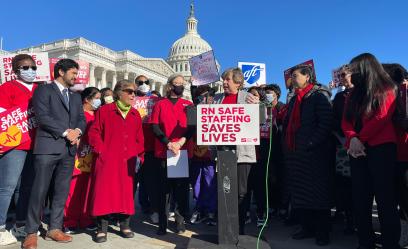THE JOB OF THE AFT, indeed the labor movement, is to fight for a better life for all: Quality healthcare and education. Good jobs with decent pay, safe working conditions, and retirement security. An economy and a democracy that enable freedom and fairness. We shouldn’t have to fight for these things, but far-right extremists—privatizers and profiteers—would rather cut corporate taxes, and enrich themselves, than invest in the American people. Their agenda threatens the bedrock of our country: our healthcare system and our public schools.
Even before COVID-19, American healthcare was deteriorating under untrammeled corporatization and consolidation. Now, nurses and other healthcare professionals are under siege: burnt out by too many patients, not enough staff, minimal safety precautions, mandatory overtime. By exhaustion, workplace injuries, and skyrocketing rates of violence that make hospitals one of the most dangerous places in America to work. By the moral injury of not being able to properly care for your patients.
As if on parallel tracks, educators in public schools are under siege too. The school privatization movement is trying to methodically starve public schools of funding while stoking fear and division (even claiming that teachers are groomers), aiming to destroy public education as we know it. Culture war operative Christopher Rufo put it bluntly: “To get to universal school choice, you really need to operate from a premise of universal public school distrust.” To this end, he says, his side has “to be ruthless and brutal.”
The AFT is fighting this scorched-earth mentality. Standing up to hospital CEOs who put profits ahead of patients and against the division of communities and defunding of schools. At the same time, we are trying to strengthen both healthcare and public schools with real-life solutions that help patients and children. In my recent national speech* defending public education, I outlined a four-part plan to help kids’ recovery and to reclaim the purpose and promise of public education: 25,000 community schools, experiential learning for all kids (including career and technical education that could feed the healthcare workforce), the revival and restoration of the teaching profession, and deepened partnerships with parents and the community.
In healthcare, we know safe patient limits are key. That’s why we launched Code Red, our $1 million national, multiyear campaign to support our healthcare workforce and protect patients by ensuring safe staffing, investing in recruitment and training, and addressing student debt and violence in all venues—from the hospital floor to collective bargaining to state and federal legislation. A recent study in New York found that if medical-surgical staffing in hospitals were four patients per nurse (instead of about six to seven per nurse), then at least 4,370 lives and $720 million would be saved over two years (largely because of shorter stays and fewer readmissions). The “savings” for those patients’ families and the nurses healing them are incalculable.
Federal legislation sponsored by Sen. Sherrod Brown and Rep. Jan Schakowsky would specify minimum nurse-to-patient staffing requirements, study best practices for nurse staffing, and ensure whistleblower protections for nurses who advocate for patients’ safety.
And we are fighting state by state. In Connecticut, we are seeking to create staffing requirements at hospitals, ban mandatory overtime for nurses, and add protections from workplace violence. In Washington state, we are pressing for a bill tasking the state Department of Labor and Industries with setting staffing standards for healthcare workers. In Oregon, passage looks hopeful for a bill codifying hospital nurse-patient ratios into state statute.
Over 100 AFT healthcare locals are involved in this campaign, many seeking to address staffing through collective bargaining. Staffing ratio language has been negotiated at sites including Ohio State University and Kaiser Permanente and in agreements at SUNY Downstate Health Sciences University, NYU Langone Health, and NYU Langone Hospital—Brooklyn in New York City.
We’re also involved in workforce development—helping to create pathway programs and providing mentoring to not just bring people into healthcare professions but also help them stay. This is what the skilled trade unions do with apprenticeships; we need to carve out the same role in healthcare.
This is union work—raising the issues of safety and fairness, and engaging in these campaigns to get these issues addressed. Together, we’ll achieve victories we could never achieve alone.
*To watch my speech, “In Defense of Public Education,” go to go.aft.org/94k. (return to article)

